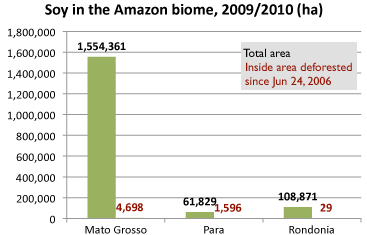The Brazilian soy industry’s moratorium is proving effective at slowing deforestation for soy production in the Amazon rainforest, reveals a new study published in the journal Remote Sensing.
Conducting aerial surveys, ground inspections, and satellite image analysis, Brazilian researchers found that only 0.4 percent of soy established in the Amazon biome since 2006 has occurred in areas deforested since the implementation of the soy moratorium.
The moratorium, which was established by the Brazilian Association of Vegetable Oil Industries (ABIOVE) and the National Association of Cereal Exporters (ANEC)—bodies that account for 92 percent of Brazil’s domestic market—in response to complaints by environmentalists over the growing role of soy expansion in driving Amazon deforestation, compels major traders to source soy from areas deforested prior to June 24, 2006 in the Amazon biome in Brazil. The moratorium is seen as a model for other commodities linked to deforestation, including cattle products, sugar cane, and palm oil.
 Soy in areas deforested since the June 24, 2006 moratorium cut-off date compared with the total soybean area within the Amazon biome. Data from Rudorff et al 2011. |
The analysis found that the state of Mato Grosso accounted for the majority of soy planted in recently deforested areas. Out of Mato Grosso’s 1.6 million total hectares of soy in the Amazon biome, 4,698 hectares (0.3 percent) have been planted on lands deforested since the moratorium’s cut-off date. The state of Pará followed with 1,596 ha (out of 63,425 ha).
The moratorium
The soy moratorium was the direct result of a 2006 Greenpeace campaign, which linked animal feed used by fast food chains, supermarkets, and retailers in Europe to deforestation in the Brazilian Amazon. The main target—McDonalds, which had been stung by the McLibel case of the 1990s and other activist campaigns—immediately demanded its suppliers provide deforestation-free soy, presenting the industry with a daunting dilemma: move towards environmental respectability or lose one of its biggest, and most influential, customers. The largest soy players—whose vast portfolio of commodities are sold globally—chose the former, agreeing to a moratorium on soy grown on newly deforested lands that has changed the way commodities are produced in the Amazon. The moratorium has been extended every year since.
Reference: Bernardo Friedrich Theodor Rudorff et al. The Soy Moratorium in the Amazon Biome Monitored by Remote Sensing Images. Remote Sens. 2011, 3, 185-202; doi:10.3390/rs3010185
Related articles